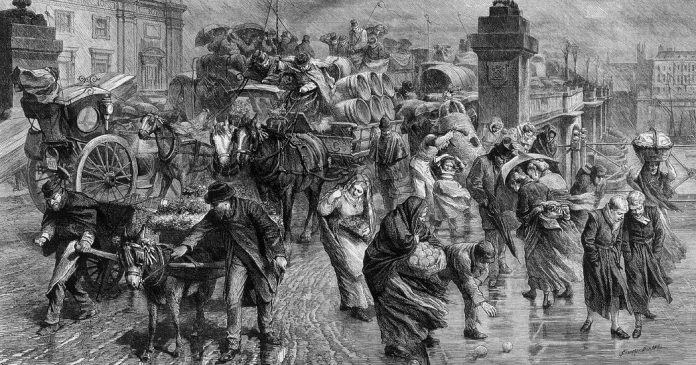Britain’s official rainfall data now return to the yr earlier than Queen Victoria ascended the throne, due to the efforts of hundreds of volunteers who, cooped up at house throughout Covid, have been introduced collectively by their ardour for a really British preoccupation: the climate.
It started when Ed Hawkins, a local weather scientist on the College of Studying in England, put out a name for assist transcribing greater than 65,000 handwritten logs of month-to-month rainfall, spanning three centuries, from throughout Britain and Eire.
The writing within the data was too irregular to be learn by machine; human eyes have been wanted. Greater than 16,000 folks answered Dr. Hawkins’s request, and collectively they chewed via the duty in a little bit over two weeks.
That was two years in the past, throughout Britain’s first coronavirus lockdown. Now, the nation’s climate company, the Met Workplace, has processed 3.3 million knowledge factors from the transcribed pages and added them to its nationwide rainfall statistics, enriching the official file with many extra observations and lengthening it again to 1836. Among the many newly digitized data is recent element on the curious climate of 1852, when an exceptionally dry spring was adopted by extreme flooding in November and December.
“If the climate that conspired to deliver us a lot rain in 1852 occurred once more, it might in all probability be placing extra rain onto our island as a result of we dwell in a hotter world,” Dr. Hawkins stated in an interview from Studying. Having higher data on previous extremes might help buttress our defenses towards future ones, he stated.
Dr. Hawkins and a group of volunteers and different researchers lay out how they processed and cleaned up the information in a examine revealed on Friday in Geoscience Knowledge Journal.
“We’ve hardly scratched the floor” of what there’s to be taught from Britain’s local weather archives, he stated. “The U.S. has huge archives as nicely, at NOAA, which haven’t but been explored as absolutely as they could be,” he added, referring to the Nationwide Oceanic and Atmospheric Administration.
The Met Workplace knew the worth of the information within the previous rainfall logbooks when it scanned them in 2019, stated Catherine Ross, an archivist on the company and an creator of the brand new examine. Nevertheless it was solely due to volunteers through the 2020 lockdown, Dr. Ross stated, that the ornately, generally idiosyncratically, handwritten data was made helpful for scientific evaluation.
The data begin in 1677 with measurements from scattered observers. By 1860, knowledge assortment was being coordinated by the British Rainfall Group, which might later turn into a part of the Met Workplace. Extra folks acquired concerned: atypical residents, clergymen, rich landowners who entrusted the duty to gardeners and groundskeepers. This final class apparently included the royals: Among the many archives are rainfall readings from Buckingham Palace, Kensington Palace and Sandringham Home.
“It’s the Victorian Age: Folks need to management, measure, perceive statistically much more intimately,” Dr. Ross stated. “There’s this elevated understanding of, ‘We are able to gather observations and do one thing with them.’”
In notes they stored with the rainfall logs, the record-keepers reveal the care they invested within the process, and among the challenges. Rev. W. Borlase, within the village of Ludgvan, Cornwall, added this footnote to his studying for October 1770: “Receiver fairly full. Might need run over. Don’t know.”
Perceive the Newest Information on Local weather Change
The observers documented numerous indignities that have been visited upon their rain gauges: vandalism by kids; obstruction by birds’ nests; harm by vacationers, garden mowers and ponies. The monks at Belmont Abbey, in Herefordshire, famous a bullet gap of their gauge in 1948. At one psychiatric hospital, record-keeping was on maintain for greater than two years within the Nineteen Fifties as a result of the gauge had been “hidden by inmates.”
As World Conflict II raged, one log from 1944 notes {that a} rain gauge was “destroyed by enemy motion.” Within the village of West Ayton, the record-keeper ended readings in 1949 with the remark “too previous to trouble now.”
As soon as the data have been transcribed, the information needed to be organized by exact location. This offered its personal challenges. The notes for one rain gauge in Scotland describe it solely as being “in a glen among the many hills.”
Dr. Hawkins is probably greatest recognized for creating the local weather stripes, a method of visualizing world warming. He’s now concerned with one other on-line challenge to transcribe climate observations made by mariners traversing the globe within the mid-Nineteenth century. It’s half of a bigger initiative, GloSAT, that goals to increase data of worldwide floor temperatures — on land, ocean and ice — again to the 1780s. In the meanwhile, most world temperature data begin within the 1850s.
The extra data might assist scientists higher perceive the Earth’s local weather earlier than the Industrial Revolution and the accompanying large-scale carbon emissions from human exercise. It might additionally reveal extra about how the local weather reacted to a number of big volcanic eruptions within the early Nineteenth century, together with the one at Mount Tambora, in what’s now Indonesia, that chilled the planet and induced the so-called “yr with no summer time.”
“We haven’t had a very huge one in all probability since Tambora in 1815,” Dr. Hawkins stated. “We’re in all probability overdue one. And so understanding the implications of an eruption like that forward of time would in all probability be fairly helpful.”


